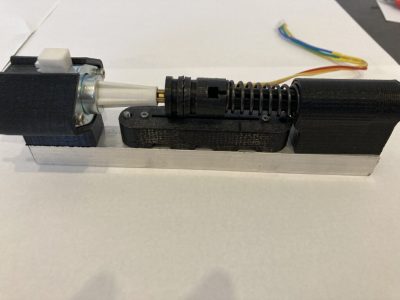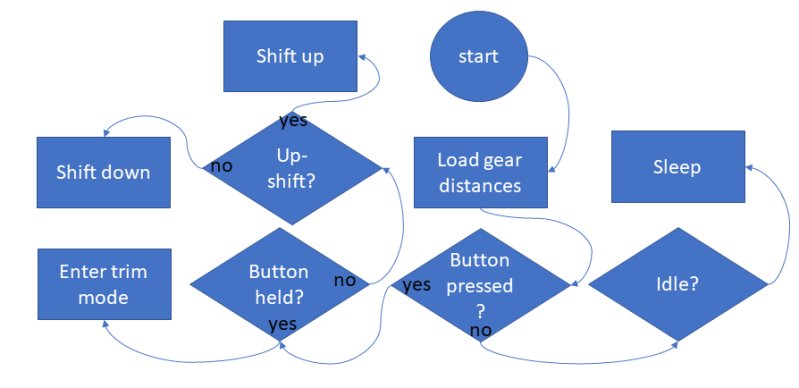For the overwhelming majority of bicycles out there that feature multiple gears, switching between these is done purely mechanically, with a cable. Generally this uses a derailleur, which forms part of the gear switching and chain tensioning mechanism. As a mechanical system, it’s reliable when well maintained, but tuning it can be a real hassle. This is where an electronic shifter should be able to provide faster, more reliable and quieter shifting, and is also where [Jesse DeWald]’s electronic shifting project begins.
 As [Jesse] points out in the introductory article on electronic shifting, it’s not a new concept, with everyone from Shimano (Di2) to Archer and others coming up with their own version. Some of these require replacing the existing derailleur, while others should allow for non-destructive modification. What [Jesse] did not find among this constellation of options was a version that’d work with existing derailleurs, did not require destructive modifications and have a long battery life.
As [Jesse] points out in the introductory article on electronic shifting, it’s not a new concept, with everyone from Shimano (Di2) to Archer and others coming up with their own version. Some of these require replacing the existing derailleur, while others should allow for non-destructive modification. What [Jesse] did not find among this constellation of options was a version that’d work with existing derailleurs, did not require destructive modifications and have a long battery life.
[Jesse]’s design omits the servo present in Archer’s design, and uses the existing derailleur spring, with the reasoning explained in a nice spring physics refresher. Instead a stepper is used along with a matched balancer spring that in testing managed over 3 months of standby time with a 3,700 mAh Li-ion battery and thousands of shifts. At the core of the system is an Arduino Pro Mini board, the code for which is available along with the design plans.
The project is not done at this point, of course, with a whole range of improvements still to be added, including a case, so that the shifter can be used outside in the rain.
















For a general rider, I think elec shifting is folly unless you make use of the ability to detect shift performance and correct for misalignment on the fly. It’s just a reason to carry around another thing that needs charging and weighs too much. There are better ways to improve on cable mechs. For a racer, sure, you have pre-race prep, everything charged, the OEM kit is super light weight and optimised.
One nice thing about electronic shifting is that you gain two additional gears b/c you don’t have to worry about dropping your chain when you cross your chain from biggest to smallest on front (crank) and back (cassette).
For performance reasons it’s true that only racers will appreciate/need the additional gears; but for people that are new to shifting (and God forbid they’re doing this at the same time as learning how to use/wear clip in pedals), not worrying about dropping your chain would be a nice feature.
A racer with a pre-race prep probably has well-lubricated, fresh cables and sheaths.
The real beauty of electronic shifting is the elimination of shifter cable drag.
Since the cable can only be pulled one way by the shifter, and a spring in the derailer opposes it in the other, shifting up/down doesn’t always result in consistent chain position. A problem that electronic shifters don’t have.
That means less grinding – less noise, less wear, more efficiency.
There’s a reason this electronic groupsets cost what they do.
” it’s reliable when well maintained, but tuning it can be a real hassle. ”
Wow. If a person is that lazy maybe they shouldn’t be on a bike to begin with.
I know lots of people that like to ride that aren’t mechanically inclined. Being capable of a routine task like changing your oil isn’t a prerequisite for driving either, it doesn’t mean they’re lazy.
I agree, it’s a *massive* hassle, and needs doing perhaps every 10-20 years for most people. Even when I was cycling 30 every day it didn’t need doing more than once a year.
I agree. I’ve been riding an average of 2500 miles per year for the last 13 years and I can count on one hand the number of times I’ve had to adjust the rear derailleur. It’s so rare that I always have to look it up in a book to remember how to do it.
I use my bike everyday and I am lazy on maintenance. It’s electric assist and it’s very reliable. I only have to worry about recharging the battery. I think the less maintenance to worry about the better the bike will be utilize.
I’ve been riding a Priority Continuum Onyx bike with an Enviolo continuously variable transmission built into the rear hub for about 2 years (maybe 6k miles) with zero maintenance and 100% reliability. They are used in higher end e-bikes because there are no internal gears to break when the motor slams them with sudden torque. 380% gear range. When you’re riding, you just shift to whatever ratio feels comfortable to pedal. The hub is sealed so there’s no oil leaking and no oil changes needed. I have no idea what the projected lifetime is, but warranty is 2 years. The bike is belt driven, too, so no oil on pants legs and no maintenance there, either.
I drove a regular 7 speed shimano internal hub for 20 years and it was fine. The rest of the bike did, so I bought another with the same gear hub.
Thanks for gatekeeping who can ride a bike.
Now let’s do it with cars. If a person is that lazy they can’t rebuild their car’s transmission, maybe they shouldn’t be driving a car to begin with.
Ok, what shall we gatekeep next?
It’s like a bowden cable, but 1000x more complicated
Interesting idea, but not something I want. I kind of like the fact that our bikes are simple, reliable, and can be fixed with a pocket-sized tool or two. Some of our bikes don’t even have indexed shifters. The only derailleur that required extra service was the Shimano Rapidfire shift levers on my mtn bike, and that was just a clean and re-lubricate.
An interesting project, I would love to follow the progress. That said nothing is more reliable or precise than Shimano Di2, it’s worth the extra investment!
Phew, nothing like a fresh round of hackaday commenters to really bring you back down to Earth! Y’all make really good points, seriously. You’re just a little mean sometimes.
That said, some quick responses:
1) This is not for everyone. It was fun, I had the parts laying around, and I smile *every* time I make a shift.
2) It weighs 1 pound. I carry 30+ lbs on my touring rig. It’s in the noise.
3) No question, it is indeed one more thing that can fail.
4) It’s significantly more precise than anything mechanical. However, that precision is totally unnecessary.
5) Agreed on the Di2 (though I’m unsure of it’s capacity: I run a triple up front and 12-36 on the cassette).
Finally, I’m just happy that people are riding bikes. Every adult that’s recently been on a bike is one less adult that’s likely to kill me with (or scream at me from) a car. Win / win.
Good on ya!
Gordon Murray would like a word with you on #4 though ;) 😂
Fixed gear 4 lyfe. Zero shifters and zero to maintain. Only works because my ride is pancake flat but…
This retrogrouch begrudging admits electronic shifting is really really trick.
This would be really useful on children’s bikes. Not all children have the grip strength to move the shifter, but have reached the age where they would benefit from gears, at less than Di2 prices.
Did this very thing. Used two buttons to an arduino. Saved gear change (9 speed) in ROM and drove a Stepper Motor with a Lead screw. Start there. Works perfect.